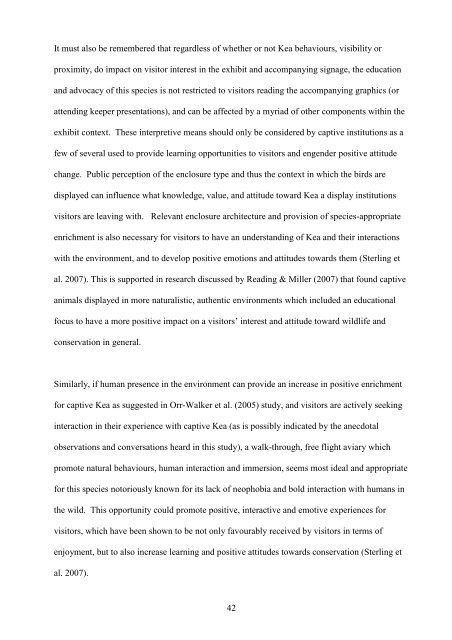The Dynamics of Kea Behaviour and Interpretive Signage on Visitor ...
The Dynamics of Kea Behaviour and Interpretive Signage on Visitor ...
The Dynamics of Kea Behaviour and Interpretive Signage on Visitor ...
You also want an ePaper? Increase the reach of your titles
YUMPU automatically turns print PDFs into web optimized ePapers that Google loves.
It must also be remembered that regardless <str<strong>on</strong>g>of</str<strong>on</strong>g> whether or not <str<strong>on</strong>g>Kea</str<strong>on</strong>g> behaviours, visibility or<br />
proximity, do impact <strong>on</strong> visitor interest in the exhibit <str<strong>on</strong>g>and</str<strong>on</strong>g> accompanying signage, the educati<strong>on</strong><br />
<str<strong>on</strong>g>and</str<strong>on</strong>g> advocacy <str<strong>on</strong>g>of</str<strong>on</strong>g> this species is not restricted to visitors reading the accompanying graphics (or<br />
attending keeper presentati<strong>on</strong>s), <str<strong>on</strong>g>and</str<strong>on</strong>g> can be affected by a myriad <str<strong>on</strong>g>of</str<strong>on</strong>g> other comp<strong>on</strong>ents within the<br />
exhibit c<strong>on</strong>text. <str<strong>on</strong>g>The</str<strong>on</strong>g>se interpretive means should <strong>on</strong>ly be c<strong>on</strong>sidered by captive instituti<strong>on</strong>s as a<br />
few <str<strong>on</strong>g>of</str<strong>on</strong>g> several used to provide learning opportunities to visitors <str<strong>on</strong>g>and</str<strong>on</strong>g> engender positive attitude<br />
change. Public percepti<strong>on</strong> <str<strong>on</strong>g>of</str<strong>on</strong>g> the enclosure type <str<strong>on</strong>g>and</str<strong>on</strong>g> thus the c<strong>on</strong>text in which the birds are<br />
displayed can influence what knowledge, value, <str<strong>on</strong>g>and</str<strong>on</strong>g> attitude toward <str<strong>on</strong>g>Kea</str<strong>on</strong>g> a display instituti<strong>on</strong>s<br />
visitors are leaving with. Relevant enclosure architecture <str<strong>on</strong>g>and</str<strong>on</strong>g> provisi<strong>on</strong> <str<strong>on</strong>g>of</str<strong>on</strong>g> species-appropriate<br />
enrichment is also necessary for visitors to have an underst<str<strong>on</strong>g>and</str<strong>on</strong>g>ing <str<strong>on</strong>g>of</str<strong>on</strong>g> <str<strong>on</strong>g>Kea</str<strong>on</strong>g> <str<strong>on</strong>g>and</str<strong>on</strong>g> their interacti<strong>on</strong>s<br />
with the envir<strong>on</strong>ment, <str<strong>on</strong>g>and</str<strong>on</strong>g> to develop positive emoti<strong>on</strong>s <str<strong>on</strong>g>and</str<strong>on</strong>g> attitudes towards them (Sterling et<br />
al. 2007). This is supported in research discussed by Reading & Miller (2007) that found captive<br />
animals displayed in more naturalistic, authentic envir<strong>on</strong>ments which included an educati<strong>on</strong>al<br />
focus to have a more positive impact <strong>on</strong> a visitors’ interest <str<strong>on</strong>g>and</str<strong>on</strong>g> attitude toward wildlife <str<strong>on</strong>g>and</str<strong>on</strong>g><br />
c<strong>on</strong>servati<strong>on</strong> in general.<br />
Similarly, if human presence in the envir<strong>on</strong>ment can provide an increase in positive enrichment<br />
for captive <str<strong>on</strong>g>Kea</str<strong>on</strong>g> as suggested in Orr-Walker et al. (2005) study, <str<strong>on</strong>g>and</str<strong>on</strong>g> visitors are actively seeking<br />
interacti<strong>on</strong> in their experience with captive <str<strong>on</strong>g>Kea</str<strong>on</strong>g> (as is possibly indicated by the anecdotal<br />
observati<strong>on</strong>s <str<strong>on</strong>g>and</str<strong>on</strong>g> c<strong>on</strong>versati<strong>on</strong>s heard in this study), a walk-through, free flight aviary which<br />
promote natural behaviours, human interacti<strong>on</strong> <str<strong>on</strong>g>and</str<strong>on</strong>g> immersi<strong>on</strong>, seems most ideal <str<strong>on</strong>g>and</str<strong>on</strong>g> appropriate<br />
for this species notoriously known for its lack <str<strong>on</strong>g>of</str<strong>on</strong>g> neophobia <str<strong>on</strong>g>and</str<strong>on</strong>g> bold interacti<strong>on</strong> with humans in<br />
the wild. This opportunity could promote positive, interactive <str<strong>on</strong>g>and</str<strong>on</strong>g> emotive experiences for<br />
visitors, which have been shown to be not <strong>on</strong>ly favourably received by visitors in terms <str<strong>on</strong>g>of</str<strong>on</strong>g><br />
enjoyment, but to also increase learning <str<strong>on</strong>g>and</str<strong>on</strong>g> positive attitudes towards c<strong>on</strong>servati<strong>on</strong> (Sterling et<br />
al. 2007).<br />
42












